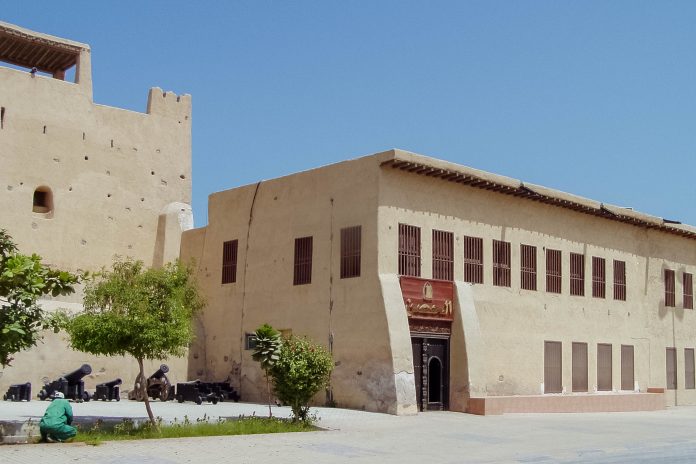Das Al Hisn Fort aus dem 18. und 19. Jahrhundert war einst Verteidigungsanlage und Wohnstätte der amtierenden Herrscher von Ras al Khaimah-Stadt und fungiert heute als Nationalmuseum.
Die Entstehung des Al Hisn Forts in der Altstadt von Ras al Khaimah-Stadt geht auf den Scheich Salim bin Sultan al Qasimi zurück, der nach der Besetzung des heutigen Emirats durch die Perser den Bau von angemessenen Verteidigungsanlagen befahl.
Und so entstand im Jahr 1749 genau dort, wo einst die Zelte der feindlichen Perser gestanden hatten, die Festung Al Hisn, die in den nächsten Jahren gemeinsam mit der Stadtmauer und weiteren Wehranlagen zu einer imposanten Verteidigungsanlage heranwuchs. Für den Bau des Forts wurden Steine, Korallen und Mörtel verwendet, die unter anderem in so manchem Wadi-Steinbruch gewonnen wurden.
Im Jahr 1819, als die Briten Ras al Khaimah besetzten und den damaligen ibn Saqr zur Unterzeichnung eines Seefriedenspakts zwangen, wurden das Al Hisn Fort und zahlreiche andere Verteidigungsanlagen zerstört.
Manche Teile wurden in den Jahren danach wieder aufgebaut, darunter der Südwestturm, der heute noch zu den ältesten im Original erhaltenen Teilen der Festung zählt. Das gesamte Fort wurde immer wieder erweitert und ausgebaut und die meisten Mauern, die heute noch stehen, stammen aus der Zeit um 1900.
Der eindrucksvolle Bau diente anfangs lediglich der Verteidigung, wurde von den Qasimi-Scheichs aber nach und nach, schließlich bis 1964 als Wohnstätte genutzt und ist somit ein optimales Beispiel für die traditionell arabische Mischung aus Wohn- und Befestigungsanlage.
Nationalmuseum von Ras al Khaimah
1987 wurde die imposante Festung einem neuen Zweck zugeführt und die altehrwürdigen Mauern beherbergen heute das Nationalmuseum von Ras al Khaimah. Am Vorplatz werden seine Besucher von einigen historischen Kanonen begrüßt.
Im Inneren der Festung liegt gleich rechts der beeindruckende (leider für Besucher nicht zugängliche) ehemalige Empfangssaal des Herrschers, der Besucher des Scheichs in ehrfürchtiges Staunen versetzen sollte. Über einen gewundenen Gang geht es tiefer ins Innere des Palastes hinein, bis zu den einstigen Wohnräumlichkeiten der Herrscherfamilie, die um einen idyllischen Innenhof gruppiert sind.
Im Osten erhebt sich der Windturm aus dem 20. Jahrhundert, der in den heißen Sommern der arabischen Wüste für angenehme Kühle sorgte. Die beiden mit Zinnen bewährten Türme dienten ausschließlich der Verteidigung, wobei jener im Südwesten noch aus den Anfangszeiten der Festung stammt.
Die Räume sind mit prachtvollen Türen geschmückt und der typischen, aus Holzbalken und Palmmatten gefertigten Zimmerdecke ausgestattet. Durch die nur mit einem Holzgitter versehenen Fenster zieht ein angenehmes Lüftchen.
Neben den Räumlichkeiten des Al Hisn Forts werden im Nationalmuseum von Ras al Khaimah auch archäologische, ethnografische und naturhistorische Ausstellungen präsentiert, die sich mit der Vergangenheit und der Flora und Fauna des Emirats befassen.





